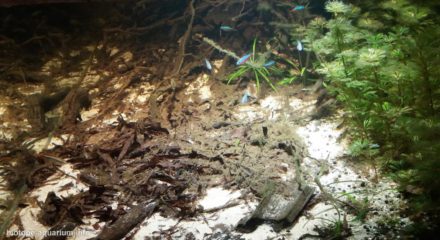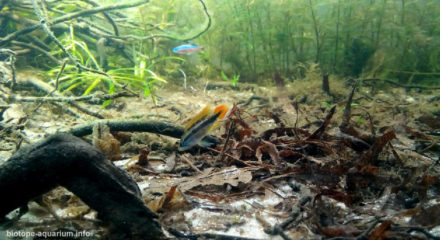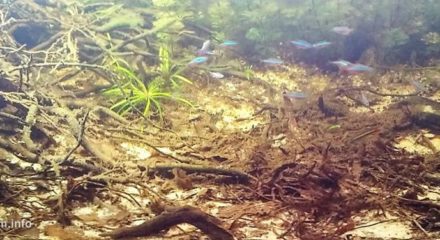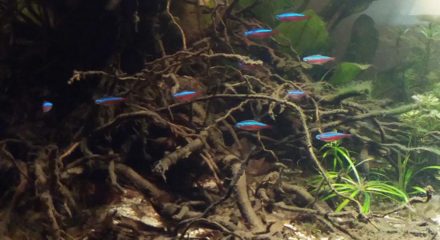Clarity branch of a river, Amazon, 120 L
16th place in Biotope Aquarium Design Contest 2016
![]() Turkey. Muhammet Saylavci
Turkey. Muhammet Saylavci
Fish and invertebrates: Apistogramma agassizi, Apistogramma agassizi blue pearl tefe, Paracheirodon axelrodi, worms
Plants list: Echinodorus tenellus, Cabomba, Echinodorus horizontalis
Biotope description: I imitiated clear tributaries of Amazon in this setup, and used all materials that belongs to South America basin. actualy host of the tank is a couple of apistogramma agassizi and its friends Tefe .Worm colony is set on the base, as to provide their nourishment just as in their natural habitat. thus, since they feel like they are in their natural habitat, their reproductivity and hunting instincts have been increased. my acquarium -which has a clear view even i used torf in it- may be resembeled to the influent streams. There are dry leaves and torf at the base, covered with sand. water lying among the roots will meet with dark waters of Amazon.
Plants list: Echinodorus tenellus, Cabomba, Echinodorus horizontalis
Biotope description: I imitiated clear tributaries of Amazon in this setup, and used all materials that belongs to South America basin. actualy host of the tank is a couple of apistogramma agassizi and its friends Tefe .Worm colony is set on the base, as to provide their nourishment just as in their natural habitat. thus, since they feel like they are in their natural habitat, their reproductivity and hunting instincts have been increased. my acquarium -which has a clear view even i used torf in it- may be resembeled to the influent streams. There are dry leaves and torf at the base, covered with sand. water lying among the roots will meet with dark waters of Amazon.
Photo Gallery
Comments of the members of the jury of Biotope Aquarium Design Contest 2016

Such a “dirty” bottom is a paradise for small Apistogrammas. Honestly, the second picture looks as if was taken in the wild. Also, the size of the aquarium corresponds well with no too high amount of fishes. Great, very natural looking work! 🙂

The description leaves much to be desired, and is not specific enough. The photographs are even a bit unclear. So why do I rate this biotope so highly? The overall impression is one of stunning realism, embodying the true spirit of a biotope aquarium. There is little to give away the game here, and the scene so closely resembles what I have seen from photos and videos of similar habitats that one could be forgiven for mistaking it for a photo of a genuine biotope. Everything from the fine fur of algae growing on the roots, to the messy, half-decayed pile up of crumbled leaf litter and twigs, to the fine layer of mulm and the graded growth pattern of the plants appears exactly as would be found in nature. It lends the piece a raw, “dirty” quality that is so often overlooked. It is the not-quite-random ordered chaos of nature, an organic display of life, growth, and decay in perfect balance. There is a fine sense of depth and that the scene continues seamlessly beyond our view. Including a population of worms as prey and decomposers adds yet another layer of realism to this miniature ecosystem, and allows the Apistogramma to display its natural hunting and foraging behaviour. This work conjures the feeling of spying undetected on a tiny corner of the wild.






